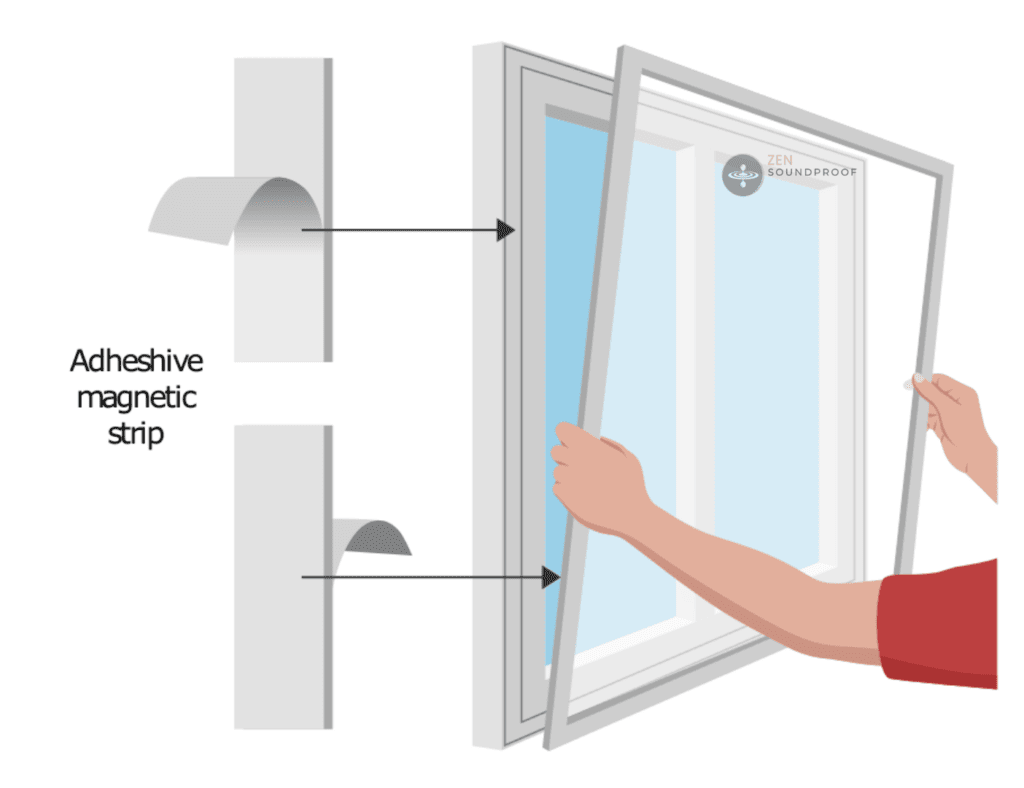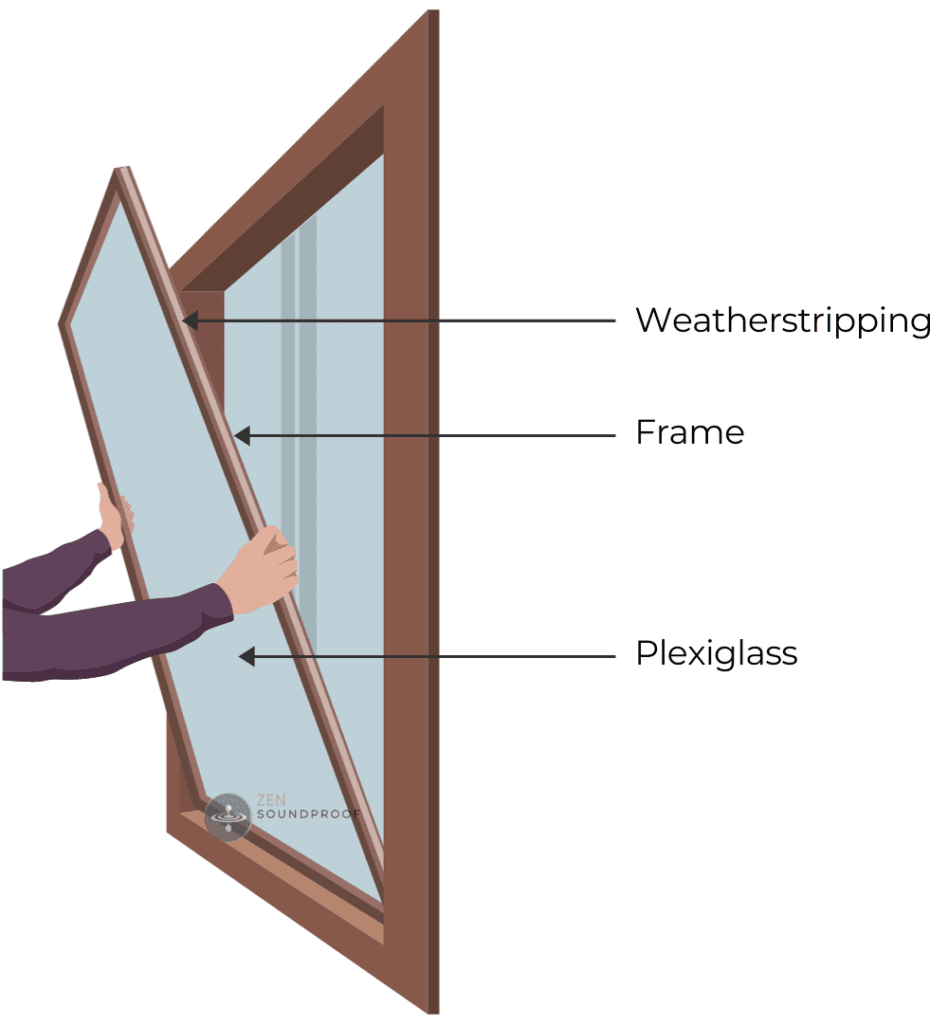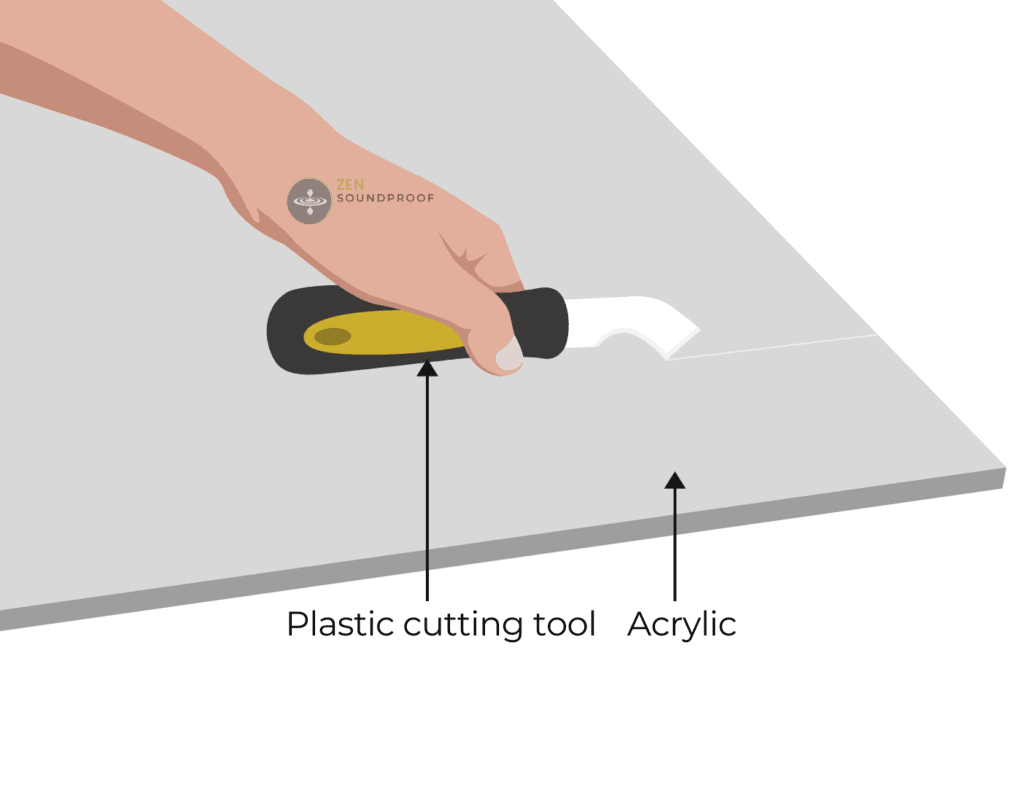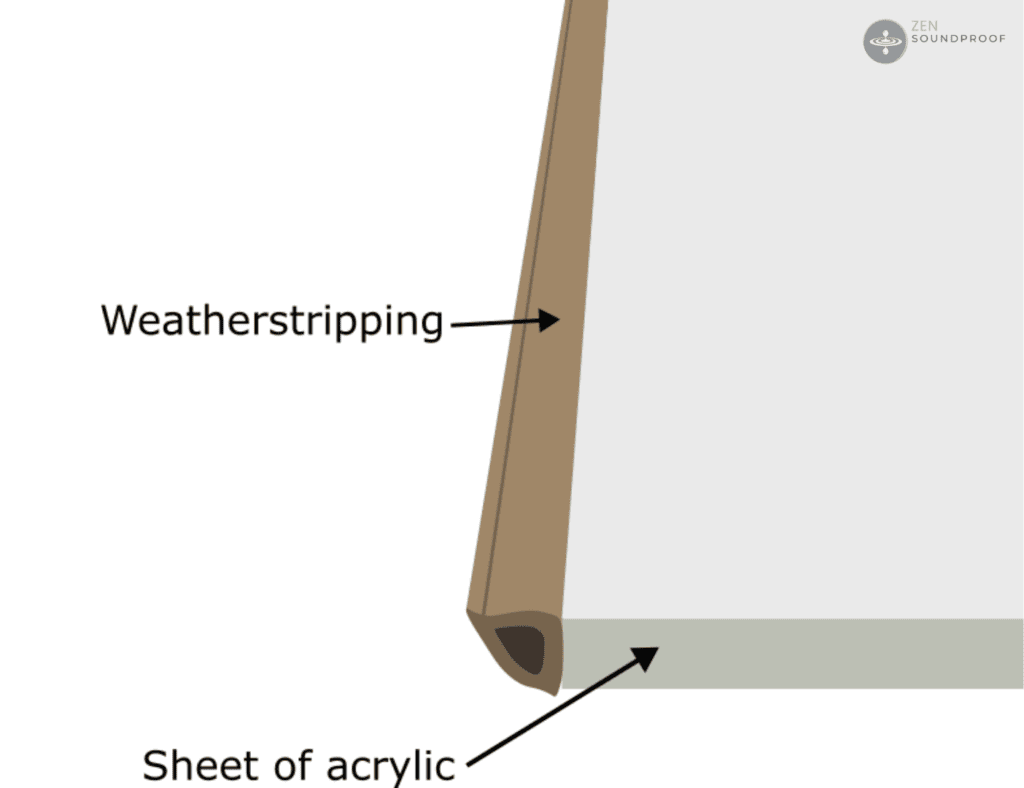In my time working with soundproofing solutions, I’ve dedicated a lot of effort to finding the best option for windows. When I lived in an inner-city apartment, I always found my windows let in too much noise – a common problem I imagine many of you face.
Although you can make your own window inserts, there are numerous soundproof window inserts available to buy.
So, let’s go over some of the best options. In this article, I’ll discuss what to look for in window inserts for noise reduction, along with a selection of some of the best products.
How Do Soundproof Window Inserts Work?
A soundproof window insert can take many different forms. At the most basic level, it consists of a sheet of PVC, acrylic, or other plastic that acts as another layer of glazing for your window.

Window inserts reduce noise by creating an air gap, which reduces sound transfer, and by adding an extra layer of material. While this layer isn’t particularly thick or mass-rich, it can make a surprising difference to the levels of outside noise coming through your window.
Are Soundproof Window Inserts Effective?
Soundproof window inserts can be effective if the right materials are used. What’s more, installation is important, as you need to properly seal the insert into place to reduce sound leakage. Soundproof window inserts can have an STC rating of 49 or more, which is very effective.
What is STC?
STC stands for Sound Transmission Class. It’s a rating used to quantify a material’s ability to block sound waves. We use it for anything from drywall and brick to glass and plastic – anything that can be considered a building material.
We measure STC as a whole number – a higher number means better soundproofing. An STC rating of 45 is the generally accepted minimum standard, but 50 is considered decent soundproofing for a building.
This table shows the difference with and without a window insert for single- and double-glazed windows. The data comes from Indow, a window insert manufacturer.
| Window Construction | STC Rating |
|---|---|
| Single Pane | 25 |
| Single Pane with Insert | 39 |
| Dual Pane | 33-35 |
| Dual Pane with Insert | 42-45 |
As you can see, the impact of a soundproof window insert on unwanted noise is far greater on a single pane window than on a dual pane. \
This is because double pane windows already have 2 layers of material and an air gap, so the insert isn’t contributing as much. A single-glazed window, however, can massively benefit from an extra layer and an air gap.
Additional Benefits of Soundproofing Window Inserts
Along with improving a window’s STC rating, there are 5 further benefits of using window inserts:
- Easy to install. Commercial window inserts generally fit into place in your existing window frame, meaning you don’t need to do any drilling, hammering or sticking.
- Cost effective. For the benefits they offer, window inserts are fairly cost-effective. Included in this is the impact it could have on your heating bills.
- Thermal benefits. On that note, adding an extra layer of window material improves its thermal efficiency by blocking drafts and reducing heat transfer.
- Transparency. Window inserts are completely clear, meaning they’ll have no effect on the window’s appearance.
- No impact on functionality. Similarly, a window insert allows you to use the window as normal because it can slip out when needed. Also, it shouldn’t get in the way of most curtains and blinds.
The bottom line is that for the cost, soundproof window inserts can be a quick and effective addition to your room. You can build your own, but buying a readymade option is far easier.
When is a Soundproof Insert Necessary?
With these benefits in mind, what are some scenarios in which a soundproof window insert would be necessary? You might want to use one if:
- You’re soundproofing on a budget. A window insert is far cheaper than replacing single pane windows with dual pane, for example.
- You need better thermal performance. Acoustic insulation might be a side-effect of needing better thermal insulation. Many window inserts do both quite well.
- You want to insulate a window without blocking it. While options like acoustic curtains exist, they obviously block light and visibility.
In short, soundproof window inserts are a viable option if you don’t want to spend lots of money insulating your window. While there may be more effective options (such as laminated glass), window inserts are a good compromise between performance and price.
The 5 Best Soundproof Window Inserts
So, let’s take a look at some of the best window inserts currently available. I won’t go into full reviews of these products, as their performance can be appropriately summarized in their STC rating. If nothing else, this list should help you narrow down your options.
1. Indow Windows
Indow is a great go-to for fairly cost-effective inserts that perform well. Also called interior storm windows, Indow Window Inserts come in 3 grades. For most domestic uses, standard will be fine, but the company also does performance and commercial.
Prices start at $31 per sq. ft. for standard inserts, and you can achieve an STC rating of up to 45 depending on your existing window.
2. Acoustical Solutions
Acoustical Solutions PrivacyShield Window Seal can achieve an STC of up to 49, which is very high for a window insert. However, this is reflected in the price, which starts at around $203 for a 2 sq. ft. panel.
3. Acoustical Surfaces
Acoustical Services Climate Seal Window Insert can reach an STC rating of 44 on standard residential windows. However, an STC of 51 is possible on commercial-grade windows that don’t open.
Unfortunately, prices are only available on request, so we can’t compare them to other products on this list. From a sheer performance perspective, though, Climate Seal is a fairly decent product.
4. CitiQuiet
CitiQuiet Window Inserts claim to block up to 95% of noise pollution coming through your window. In terms of STC ratings, this can be up to 54, which is quite good. Again, this depends on the existing window as well as the insert you choose.
As for pricing, you have to contact them for a specific estimate for your windows. In a blog post from 2014, CitiQuiet claims it can cost as little as $75 per window. But this information is nearly 10 years old, so these inserts are probably more expensive now.
5. Magnetite
Magnetite Window Inserts can increase a window’s STC rating up to 41 based on a standard dual pane window. It uses acrylic panes and magnetic edging for a quick-to-install solution. Again, there are no specific prices on the website, so we have no way to compare it to other options.
What to Consider When Choosing Soundproof Window Inserts
When it comes to choosing the best window inserts for your needs, there are a few things to think about. These include:
Noise Reduction Performance
Measured as STC ratings, we ideally want a minimum benchmark of around 40. At this point, loud noises can be heard but aren’t intelligible. A rating of 45 and above reduces this further, to the point where you can’t hear them at all (50 and above).
Bear in mind, this is the insert’s performance when combined with your existing window. There are numerous factors involved in calculating your setup’s rating, including glass type, size of the air gap, frame material, etc.
As such, you should use information available on a company’s website (such as the ratings I’ve included above) to narrow down your options. From there, it’s usually worth contacting the company directly to get a custom quote based on your existing windows.
Price
Noise performance should primarily be balanced against price. Although you should also consider the other factors I mention below, these 2 are the most important.
For example, look at Indow and Acoustical Solutions’ products above. Indow can reach an STC of 45 and costs $31 per sq. ft. On the other hand, Acoustical Solutions can reach an STC of 49 and costs, roughly, $100 per sq. ft.
Is the 4-point increase worth an extra $70? Probably not, unless you’re dealing with particularly loud and annoying noise pollution. Of course, you’ll want to get specific quotes from your choices to make this decision with relevant information.
Material of the Pane
Most products will use acrylic for the pane. Although other options include polycarbonate and PVC, acrylic is low-cost and performs well. It’s also decent for durability and scratch resistance, which are other points you need to consider.
The bottom line is that the difference in performance of these materials is fairly negligible, and acrylic should be the cheapest. For most domestic projects, it should be enough.
Material of the Seal
Another important point is the material that’s used to seal the insert. The seal helps block noise and provide thermal insulation. It’ll most likely be rubber or foam, both of which have similar performance.

You’ll want something that compresses to create a tighter seal. Indow’s product, for example, uses silicone compression tubing. This helps it fit snugly into the existing frame and reduce sound leakage.
When researching your options, see what the manufacturers say about their seal material. You want something that’s durable and ideally compresses to create a tight fit.
Size and Fit
Window inserts, unsurprisingly, need to be the same size as your existing window. If you have standard-sized windows, it should be easy to find a few options. However, if your windows are non-standard, you’ll likely have to do a bit of research.
You should find some companies do custom-sized inserts, which may be made to order. While these might be more expensive, it’s a price you’ll have to pay to reduce sound transmission.
When measuring your windows, you’ll probably need to subtract an inch or so from your measurements. This is to accommodate the frame and seal material. Most manufacturers should have a measuring guide (such as this one from CitiQuiet), so read through it before getting your quote.
Making Use of Your Window Inserts
So, you’ve decided to buy some soundproof window inserts. What next? Well, it’s worth understanding the installation and maintenance processes to get the most from your new inserts.
Let’s cover some basics to get you started.
Installation and Removal
The exact installation process will vary depending on the product you bought. However, it should be along the lines of the following:
- Start by installing the bottom edge. This should involve pushing the seal into place.
- Next, move to the top edge and repeat the process.
- From there, you can begin working down the sides, pushing the seal so it’s tight.
- Tuck in any stray seal tubing, and peel off any cover, and you’ll be done.
Some other inserts are magnetic. To install these, you’ll probably need to stick a set of magnets in place and then basically follow the installation steps above.
You can watch this installation video from Indow for a rough idea of the process. As you can see, it’s pretty straightforward.
Removal will basically be this process in reverse. Some products might have a hook or handle you can pull, whereas others will require you to stick a finger into the seal to move it.
Maintaining Your Window Insert
Cleaning your window insert is pretty simple. You should clean it at least once a year, or more often if it’s getting dirty.
To clean it, simply spray on some glass cleaner and wipe it with a lint-free cloth. It shouldn’t need anything more intense – just treat it like any other window in your home.
You’ll also need to wipe down the seal with a damp cloth to remove any dirt buildup. Make sure you do this regularly to ensure it can compress properly and there isn’t any debris impacting its performance.
Alternatives to Soundproof Window Inserts
Soundproof window inserts are a pretty easy option for reducing noise transmission. But if you want something that’s lower investment, consider these window treatments:
DIY Window Insert
I’ve mentioned the idea of a DIY window insert a few times in this article. While it’ll require a bit more effort, it can work out cheaper. Plus, you can tailor the materials and size to your windows.

I’ve written a how-to guide on DIY window inserts, so check that out for the steps and some product recommendations.
Soundproof Curtains
Soundproof curtains are an inconspicuous option for reducing noise coming from windows. After all, who would look twice at curtains?
Soundproof curtains include extra layers of fabric to improve acoustic insulation in a room. Bear in mind, though, that these don’t offer the same kind of sound blocking as a window insert.
Instead, they’re better for absorption, but this can reduce sound transmission by muffling sounds that make it through the window. Just don’t expect them to soundproof your room.
Weatherstripping
Weatherstripping is a similar material to the stuff you’ll find around the edge of a window insert. Also known as window sealing tape, it’s designed to compress into gaps to reduce noise transmission.

Weatherstripping can help reduce drafts, too. While it won’t do loads on its own, sealing any obvious gaps between the window and frame will help muffle sounds coming through.
Window Plug
A window plug is essentially a window insert that you can remove more easily. Generally, they’re designed to improve soundproofing at the expense of visibility because they can feature acoustic foam, mass loaded vinyl, and other high-performing elements.
I’ve got a full article on how to build a soundproof window plug, so check that out for some instructions.
Final Thoughts
Choosing decent soundproof window inserts for your home does mean balancing a few factors. However, the information above should help you understand these better, allowing you to make an informed decision about what you need.
I hope one of the products I’ve listed will suit your windows and requirements. If not, it should be easy enough to choose another product (or to make your own!).
Have you bought and installed window inserts for noise reduction? I’d love to hear any feedback you have, especially if I’ve linked the product you bought. Let me know in the comments.
